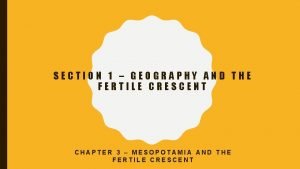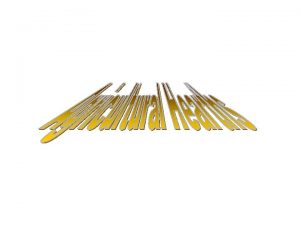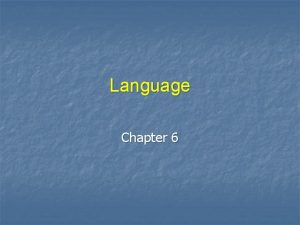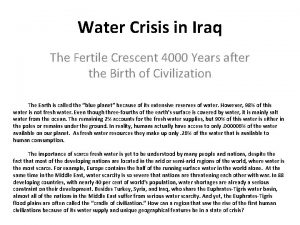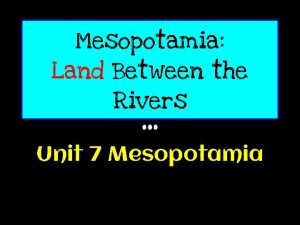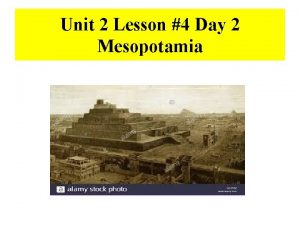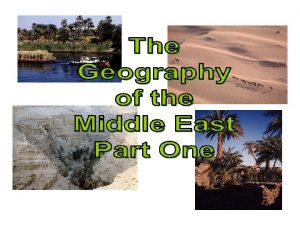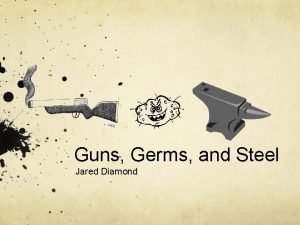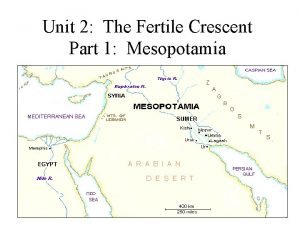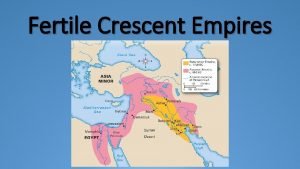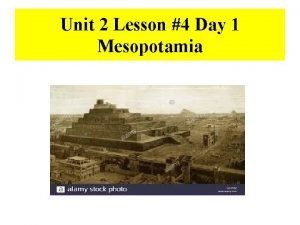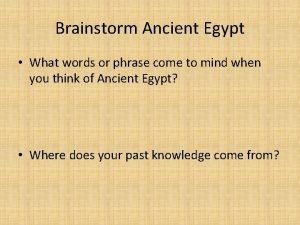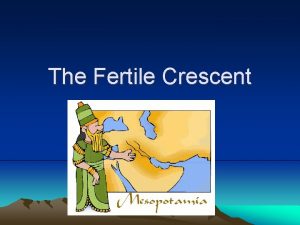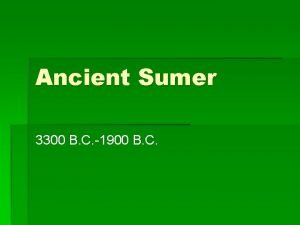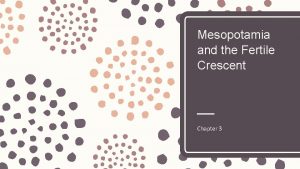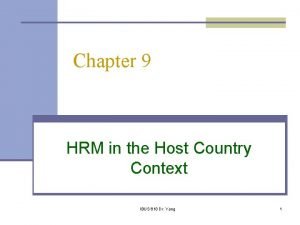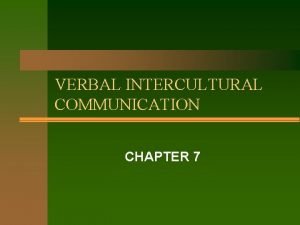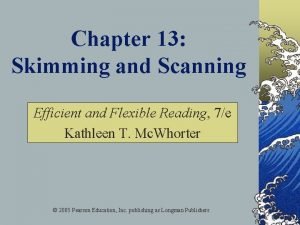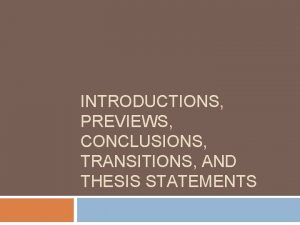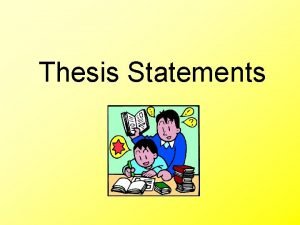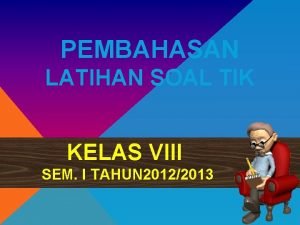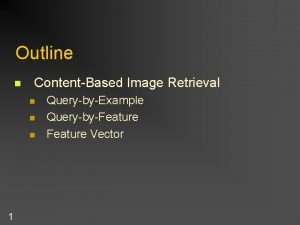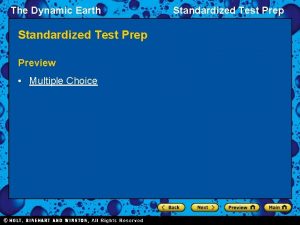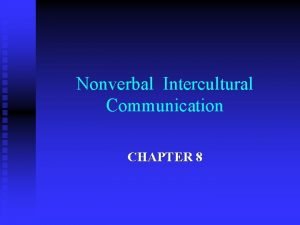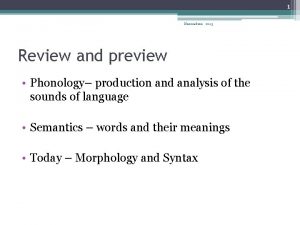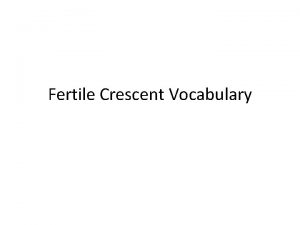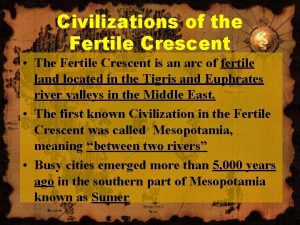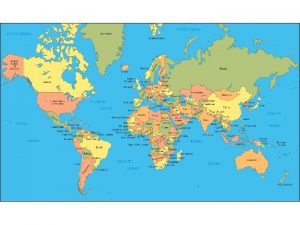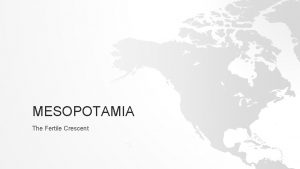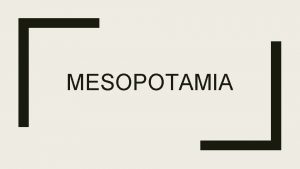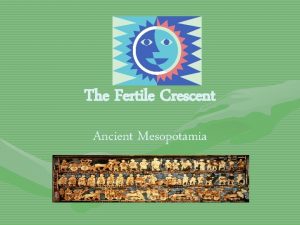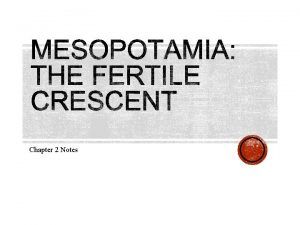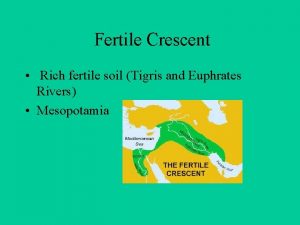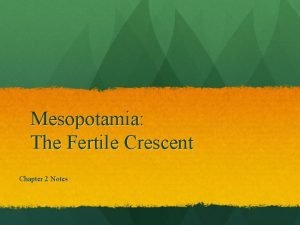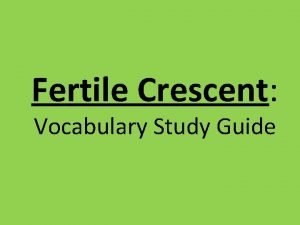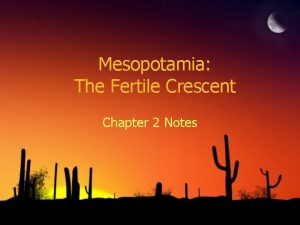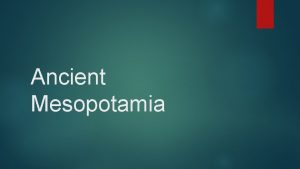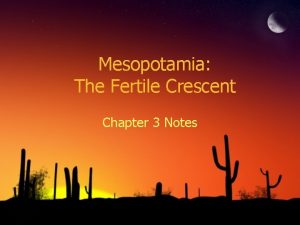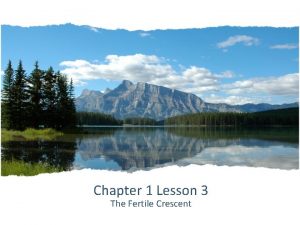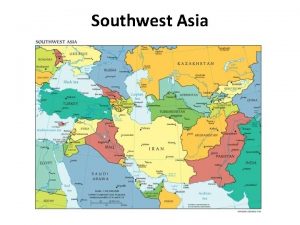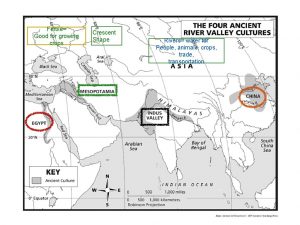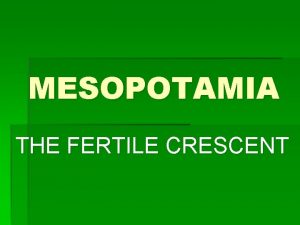The Fertile Crescent Preview What country is this





































- Slides: 37

The Fertile Crescent

Preview • What country is this? – What significant features stand out to you? – What cues did you use from the photograph to determine the name of the country? • Is this a place you would consider visiting? Why or why not.


Processing • Phocenia wh/ = modern day Lebanon – What cues did you use from the photograph to determine the name of the country? • Is this a place you would consider visiting? • Why or why not do you think this city was and is important?

• The Fertile Crescent –Israel, Jordan, Syria, Lebanon, Iraq –Tigris & Euphrates • Mesopotamia: Land between the rivers

Civilization begins 1. Growth of cities – 3000 BCE approx. 12 cities – City=center of trade for lg area 2. Specialized labor – Everyone w/ own job – Artisan – Food=$ (how priest were paid)

3. Writing – Pictographs – Ideographs – Cuneiform= “wedge shaped” (pg 21) 4. Advanced Technology – Wheel, plow, sailboat (3000 BCE) – Bronze Age 2800 BCE – Combination of copper & tin

5. Complex Institutions – Long lasting patterns of organization – Gov’t marriage, religion, etc. Geographic Problems & Sumer (Sumerian) 3000 -2000 BCE 1. H 20: unknown when the rivers would flood; dried mud=desert – Created irrigation system

2. Defense – Sumer: size of Massachusetts – Major city; Ur – Reed huts; not natural barriers – Built walls wh/ = creation of bricks 3. Resource – Traded grain for metal

Religion Polytheistic: – Anu, Enlil, Ea w/ 3000 subgods – Gods were immortal: all powerful w/ human traits – Ziggurats were built for the priest – After-life called: land of no return – Priest: please gods, ran farms, collected taxes, declared war

4100 BCE in Iraq

Class Divisions • Priest & nobles • Merchants • Workmen (farmers/artisans) • Slaves

War determined leadership –Who was the best fighter=leader –Leader passes power down to his oldest son –Began the concept of “kingship” wh/ later=monarchy –War for 1000 years

Sumer defeated by Amorites 2000 -1800 BCE –Hammurabi –Babylon –Eventually conquered all st of Meso. Wh/ = 1 empire

Hammurabi’s Code ( 1792 -1750 BCE) • Babylon needed law –Carved on stone columns (stele) – 3500 cuneiform lines – 282 specific laws – 88 w/ marriage, family, property

Principles of the code (pg 33) • Retaliation • Double standard btwe. rich & poor; men & women • Gov’t responsible for society

• Babylon conquered by nomadic warriors circa 1550 BCE –Territory controlled by many little groups for 700 years • One of those little groups called the Phoenicians




Phoenicians 1000 -700 BCE • 100 BCE powerful traders & merchants • Tyre: snails=purple dye – 60, 000 sn. = 1 lb of dye • Trade due to lack of resources • Est. colonies in Africa including Carthage • Alphabet: reduced the 600 symbols system to 22 symbols

The Jews 2000 -586 BCE • 2000 BCE group of Jews left Sumerian st. • Abraham & Sarah led nomadic group to Canaan (Palestine) • Monotheism: Supreme being, Creator of all things, ruler f the universe –God went w/ them

• 1650 BCE famine & drought came to Canaan • Many people-including Jewsmigrated to Egypt • Honor to slaves • 1300 -1200 Jews fled: Moses –Sinai peninsula; Mt. Sinai = 10 commandments=Covenant=1 st ethical law

Making the Connection How are the Ten Commandments different from Hammurabi’s Code? Have the Ten Commandments influenced modern law in the US and other Western countries?

• Judaism recognized as new religion: Justice, Morality, Relationship • Again to Canaan=Promised Land – Israel: Jerusalem – Canaanites not happy – Kings needed: 1020 -922 1. Saul 2. David 3. Solomon

• Solomon –Ark of the covenant –Increased taxes – 922: Israel (N) Judah (S)

Iron Age: Bronze out Iron in • Assyrians 850 -612 BCE –Assurbanipal (Persian Gulf to Med. ) –Greatest power in SW Asia – 1 st trained army –Tortured, killed, enslaved, removed –Nineveh; library w/ over 25, 000 writings

Asshurbanipal on a chariot during a royal lion hunt.

Chaldeans 612 -564 BCE • Reestablished Babylon st • 1 empire • Nebuchadnezzar II (605 -562) –Hanging gardens (pump system) –Dies @ 43 end of Meso. empires

An engraving inside an onyxstone-eye in a Marduk statue that depicts Nebuchadnezzar II


• Stargazers –Ziggurats over 300 ft. high –Priest & stars –Months –Destiny –Zodiac: 12 constellations –Moon: months divided 4 week

Babylonian Captivity • Jerusalem conquered 586 BCE • Jews taken as slaves to Babylon • Monotheism spread

Making the Connection Why is the spread of monotheism an important event in the development of civilizations?

Persians 550 -350 BCE • Left local customs alone • Babylon welcomed Persians and Cyrus prayed to their gods • Jews back to Jerusalem – Torah in print • 20 provinces w/ multi nationalities • Satraps = governors in charge of ea. Province • Road & Coinage system: standard $

• Zoroaster –Ahura-Mazda (truth & light) –Ahriman (evil & darkness) –Humans knowingly picked a side st – 1 hopeful religion

Zoroaster: Iranian prophet and poet
 Geography of the fertile crescent
Geography of the fertile crescent Agricultural hearths
Agricultural hearths Geography of the fertile crescent
Geography of the fertile crescent Multilingual state
Multilingual state Where's the fertile crescent
Where's the fertile crescent Esopotamia
Esopotamia Unit 2 lesson 4 fertile crescent
Unit 2 lesson 4 fertile crescent Fertile crescent
Fertile crescent Fertile crescent
Fertile crescent Fertile crescent
Fertile crescent Babylon
Babylon Unit 2 lesson 4 fertile crescent
Unit 2 lesson 4 fertile crescent Fertile crescent ap human geography definition
Fertile crescent ap human geography definition Hyksos invasion of egypt
Hyksos invasion of egypt Geography of the fertile crescent
Geography of the fertile crescent 3300 bc
3300 bc Geography of the fertile crescent
Geography of the fertile crescent The fertile crescent is the arc of land that
The fertile crescent is the arc of land that Fertile crescent
Fertile crescent Host country and home country
Host country and home country Intra country vs inter country
Intra country vs inter country Test prep preview
Test prep preview Example of verbal intercultural communication
Example of verbal intercultural communication What is overview skimming
What is overview skimming What is a preview statement
What is a preview statement The selection preview
The selection preview Thesis statement summary
Thesis statement summary Tams college acceptance
Tams college acceptance Disadvantages of realistic job preview
Disadvantages of realistic job preview Line between pada perintah column digunakan untuk membuat
Line between pada perintah column digunakan untuk membuat Test prep preview
Test prep preview Nnn image preview
Nnn image preview 1984 book preview
1984 book preview Test prep preview
Test prep preview Test prep preview
Test prep preview Multi-channeled definition in communication
Multi-channeled definition in communication Review and preview
Review and preview Classic trio' of selection techniques
Classic trio' of selection techniques
